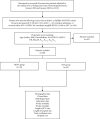High-Flow Nasal Cannula versus Noninvasive Ventilation in AECOPD Patients with Respiratory Acidosis: A Retrospective Propensity Score-Matched Study
- PMID: 37096166
- PMCID: PMC10122591
- DOI: 10.1155/2023/6377441
High-Flow Nasal Cannula versus Noninvasive Ventilation in AECOPD Patients with Respiratory Acidosis: A Retrospective Propensity Score-Matched Study
Abstract
Background: Limited data are available about the clinical outcomes of AECOPD patients with respiratory acidosis treated with HFNC versus NIV.
Methods: We conducted a retrospective study to compare the efficacy of HFNC with NIV as initial ventilation support strategy in AECOPD patients with respiratory acidosis. Propensity score matching (PSM) was implemented to increase between-group comparability. Kaplan-Meier analysis was utilized to evaluate differences between the HFNC success, HFNC failure, and NIV groups. Univariate analysis was performed to identify the features that differed significantly between the HFNC success and HFNC failure groups.
Results: After screening 2219 hospitalization records, 44 patients from the HFNC group and 44 from the NIV group were successfully matched after PSM. The 30-day mortality (4.5% versus 6.8%, p = 0.645) and 90-day mortality (4.5% versus 11.4%, p = 0.237) did not differ between the HFNC and NIV groups. Length of ICU stay (median: 11 versus 18 days, p = 0.001), length of hospital stay (median: 14 versus 20 days, p = 0.001), and hospital cost (median: 4392 versus 8403 $USD, p = 0.001) were significantly lower in the HFNC group compared with NIV group. The treatment failure rate was much higher in the HFNC group than in the NIV group (38.6% versus 11.4%, p = 0.003). However, patients who experienced HFNC failure and switched to NIV showed similar clinical outcomes to those who first received NIV. Univariate analysis showed that log NT-proBNP was an important factor for HFNC failure (p = 0.007).
Conclusions: Compared with NIV, HFNC followed by NIV as rescue therapy may be a viable initial ventilation support strategy for AECOPD patients with respiratory acidosis. NT-proBNP may be an important factor for HFNC failure in these patients. Further well-designed randomized controlled trials are needed for more accurate and reliable results.
Copyright © 2023 Meng Wang et al.
Conflict of interest statement
The authors declare that there are no conflicts of interest.
Figures
Similar articles
-
High-Flow Nasal Cannula Oxygen Therapy versus Non-Invasive Ventilation for AECOPD Patients After Extubation: A Systematic Review and Meta-Analysis of Randomized Controlled Trials.Int J Chron Obstruct Pulmon Dis. 2022 Aug 30;17:1987-1999. doi: 10.2147/COPD.S375107. eCollection 2022. Int J Chron Obstruct Pulmon Dis. 2022. PMID: 36065316 Free PMC article.
-
Non-invasive ventilation for the management of acute hypercapnic respiratory failure due to exacerbation of chronic obstructive pulmonary disease.Cochrane Database Syst Rev. 2017 Jul 13;7(7):CD004104. doi: 10.1002/14651858.CD004104.pub4. Cochrane Database Syst Rev. 2017. PMID: 28702957 Free PMC article.
-
Outcomes of early high-flow nasal cannula (HFNC) use in pediatric respiratory distress in acute settings: a meta-analysis.Eur J Pediatr. 2025 Jun 5;184(7):393. doi: 10.1007/s00431-025-06219-0. Eur J Pediatr. 2025. PMID: 40467999
-
Efficacy and safety of high-flow nasal cannula versus noninvasive ventilation for pulmonary arterial hypertension-associated acute respiratory failure: A retrospective cohort study stratified by the severity of right ventricular dysfunction.Medicine (Baltimore). 2025 Jul 4;104(27):e43185. doi: 10.1097/MD.0000000000043185. Medicine (Baltimore). 2025. PMID: 40629562 Free PMC article.
-
Using the ROX Index to Predict Treatment Outcome for High-Flow Nasal Cannula and/or Noninvasive Ventilation in Patients With COPD Exacerbations.Respir Care. 2024 Aug 24;69(9):1100-1107. doi: 10.4187/respcare.11544. Respir Care. 2024. PMID: 38653556
Cited by
-
High-velocity nasal insufflation versus noninvasive positive pressure ventilation for moderate acute exacerbation of chronic obstructive pulmonary disease in the emergency department: A randomized clinical trial.Acad Emerg Med. 2025 Apr;32(4):403-413. doi: 10.1111/acem.15038. Epub 2024 Dec 11. Acad Emerg Med. 2025. PMID: 39663589 Free PMC article. Clinical Trial.
-
Physiological effects and clinical evidence of high-flow nasal cannula during acute exacerbation in COPD patients: A narrative review.J Intensive Med. 2024 Dec 19;5(2):127-133. doi: 10.1016/j.jointm.2024.10.005. eCollection 2025 Apr. J Intensive Med. 2024. PMID: 40241833 Free PMC article. Review.
-
Is high flow nasal therapy still warranted for patients with AECOPD and acute hypercapnic respiratory failure?Ann Intensive Care. 2025 Jul 7;15(1):89. doi: 10.1186/s13613-025-01511-6. Ann Intensive Care. 2025. PMID: 40622643 Free PMC article. No abstract available.
-
High flow nasal cannula versus non-invasive ventilation in the treatment of acute exacerbations of COPD with acute-moderate hypercapnic respiratory failure.Crit Care. 2024 Sep 19;28(1):313. doi: 10.1186/s13054-024-05094-9. Crit Care. 2024. PMID: 39300587 Free PMC article. No abstract available.
-
High-flow nasal therapy versus non-invasive ventilation for AECOPD: navigating beyond a simple choice- are we asking the right questions??Ann Intensive Care. 2025 Jul 2;15(1):87. doi: 10.1186/s13613-025-01510-7. Ann Intensive Care. 2025. PMID: 40601166 Free PMC article. No abstract available.
References
-
- Halpin D. M. G., Criner G. J., Papi A., et al. Global initiative for the diagnosis, management, and prevention of chronic obstructive lung disease. The 2020 GOLD science committee report on COVID-19 and chronic obstructive pulmonary disease. American Journal of Respiratory and Critical Care Medicine . 2021;203(1):24–36. doi: 10.1164/rccm.202009-3533so. - DOI - PMC - PubMed
Publication types
MeSH terms
LinkOut - more resources
Full Text Sources
Medical
Research Materials
Miscellaneous



